seat adjustment AUDI Q5 2017 Owners Manual
[x] Cancel search | Manufacturer: AUDI, Model Year: 2017, Model line: Q5, Model: AUDI Q5 2017Pages: 296, PDF Size: 74.43 MB
Page 62 of 296

Seat s and sto rage
Seats and storage
General information
Why is your seat adjustment so important?
The safety belts and the airbag system can only
provide maximum protection if the front seats are correctly adjusted .
There are various ways of adjusting the front
seats to provide safe and comfortable support
for the dr iver and the front passenger . Adjust
your seat properly so that:
- you can easily and quickly reach all the switches
and controls in the instrument panel
- your body is properly supported thus reducing
physical stress and fatigue
- the safety belts and a irbag system can offer
maximum protection ¢
page 148.
In the following sections, you will see exact ly
how you can best adjust your seats.
There are spec ial regulat ions and instr uctions for
installing a c hild safety seat on the front pas
senger 's seat . Always fo llow the information re
garding child safety provided in ¢
page 168,
Child safety.
A WARNING
Incorrect seating position of the driver and all
other passengers can result in serious person
al injury.
- Always keep your feet on the floor when the
vehicle is in motion - never put your feet on
top o f the instrument pane l, o ut of the win
dow o r on top of the sea t cushion. This ap
plies espe cially to the passenge rs.
If your
seat ing pos ition is inco rre ct, you increase
the risk of injury in the case of sudden b rak
ing or an accident . If the airbag inf lates and
the seating position is incor rect, this could
result in personal injury or even death.
- It is important for both the driver and front
passenge r to keep a d istance o f at least
10 inches (25 cm) between themselves and
the steering wheel and/or instrument pan el. If you're s itting any closer than this, the
airbag system cannot pro tect you properly.
60
In addition, the front seats and head re
straints must be adjusted to your body
he ight so that they can give you maximum
protection .
- Always try to keep as much distance as pos
sible between yourself and the steer ing
wheel or instrument panel.
- Do not adjust the driver's or front passeng
er's seat while the veh icle is moving. Yo ur
seat may move unexpectedly, causing sud
den loss of vehicle contro l and personal in
jury. If you ad just yo ur seat while the veh icle
is moving, you a re o ut of pos ition.
, Driver's seat
The correct seat position is important for safe
and relaxed driving .
We recommend that you adjust the dr iver's seat
i n the following manner:
.. Adjust the seat in fore and aft direction so that
you can easi ly push the pedals to the floor
while keep ing your knees slightly bent¢
A. in
Why is your seat adjustment so important? on
page 60 .
.. Adjust the seatback so that when yo u sit with
your back agains t the seatback, you can still
gras p the top of the steering wheel.
.. Adjust the head res traint so the uppe r edge is
as even as possib le w ith the top of you r head. If
that is not possible, try to adjust the head re
straint so that it is as close to this pos it ion as
possible ¢
page 64.
A WARNING
Neve r place any objects in the dr iver's foo t
well. An object could get into the pedal area and inte rfere with pedal function. In case of
sud den bra king or an ac cident, you w ould no t
be ab le to b rake o r accelerate.
-
Page 63 of 296
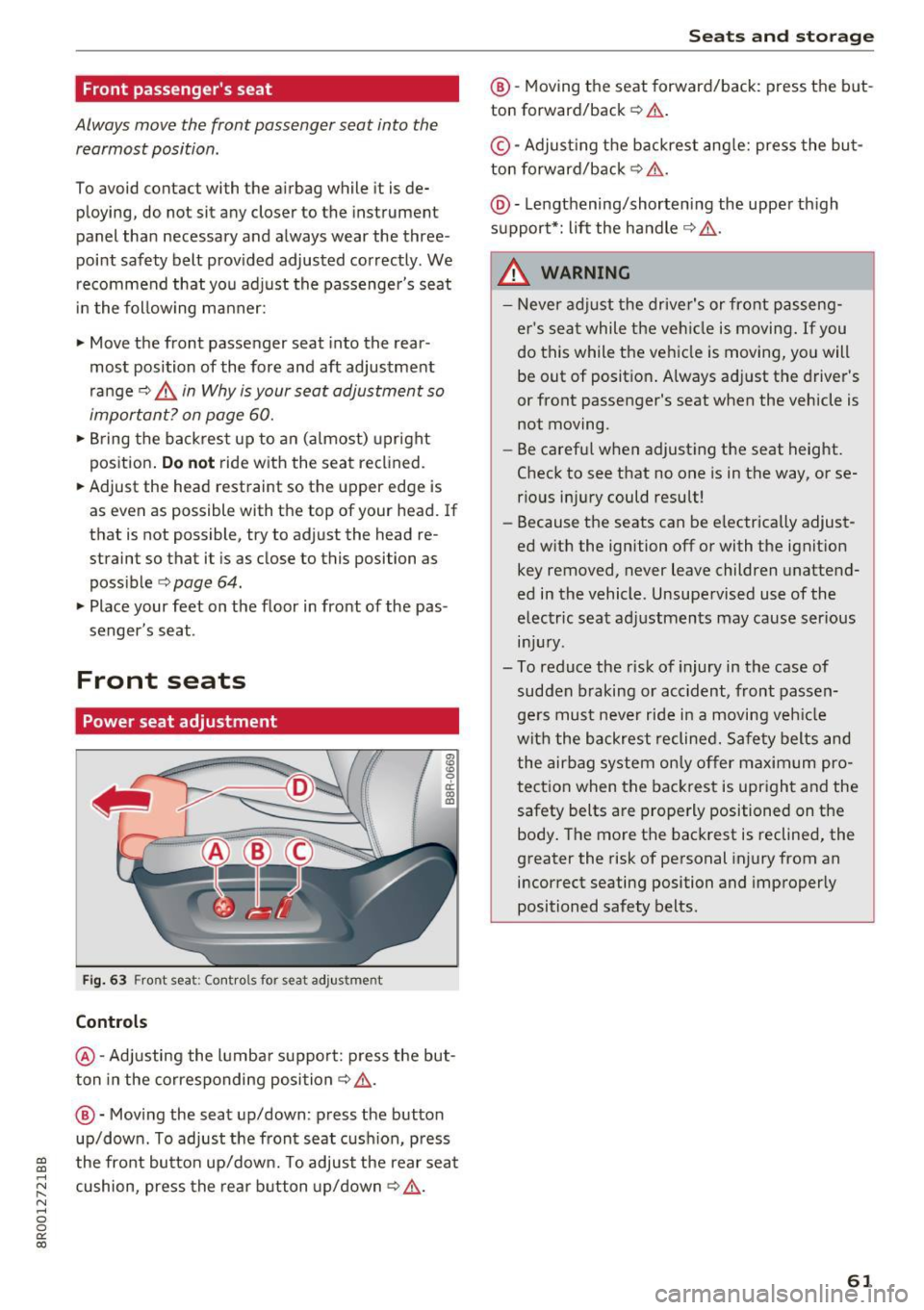
a,
a,
..... N ,....
N ..... 0 0
0:
co
Front passenger's seat
Always move the front pas senger seat into the
rearmost position .
To avoid contact with the airbag while it is de
ploying, do not sit any closer to the instrument
panel than necessary and always wear the three
point safety belt provided adjusted correctly . We
recommend that you adjust the passenger's seat
in the following manner:
.. Move the front passenger seat into the rear
most position of the fore and aft adjustment
range
c;> .&. in Why is your seat adjustment so
important? on page 60.
• Bring the backrest up to an (almost) upright
position.
Do not ride with the seat reclined .
.. Adjust the head restraint so the upper edge is
as even as possible with the top of your head. If
that is not possible, try to adjust the head re
straint so that it is as close to this position as
possible
c;> page 64 .
.. Place your feet on the floor in front of the pas
senger's seat .
Front seats
Power seat adjustment
Fig. 63 Fro nt seat: Contro ls fo r seat adjus tme nt
Controls
"' 0 ci: a, a,
@ -Adjusting the lumbar support: press the but
ton in the corresponding position¢
Le,..
@ -Moving the seat up/down : press the button
up/down . To adjust the front seat cushion, press
the front button up/down. To adjust the rear seat
cushion, press the rear button up/down¢
Le,. .
Seats and storage
@-Moving the seat forward/back: press the but
ton forward/back
~ & .
©-Adjusting the backrest angle: press the but
ton forward/back
c;> & .
@ -Lengthening/shortening the upper thigh
support*: lift the handle
c;> Le,. .
_&. WARNING
- Never adjust the driver's or front passeng
er 's seat while the vehicle is moving.
If you
do this while the vehicle is moving, you will
be out of position . Always adjust the driver's
or front passenger's seat when the vehicle is
not moving.
- Be careful when adjusting the seat height.
Check to see that no one is in the way, or se
rious injury could result!
- Because the seats can be electrically adjust
ed with the ignition off or with the ignition
key removed, never leave children unattend
ed in the vehicle . Unsupervised use of the
electric seat adjustments may cause serious injury .
- To reduce the risk of injury in the case of
sudden braking or accident, front passen
gers must never ride in a moving veh icle
with the backrest reclined. Safety belts and
the airbag system only offer maximum pro
tection when the backrest is upright and the
safety belts are properly positioned on the
body. The more the backrest is reclined, the
greater the risk of personal injury from an
incorrect seating position and improperly
positioned safety belts.
-
61
Page 64 of 296
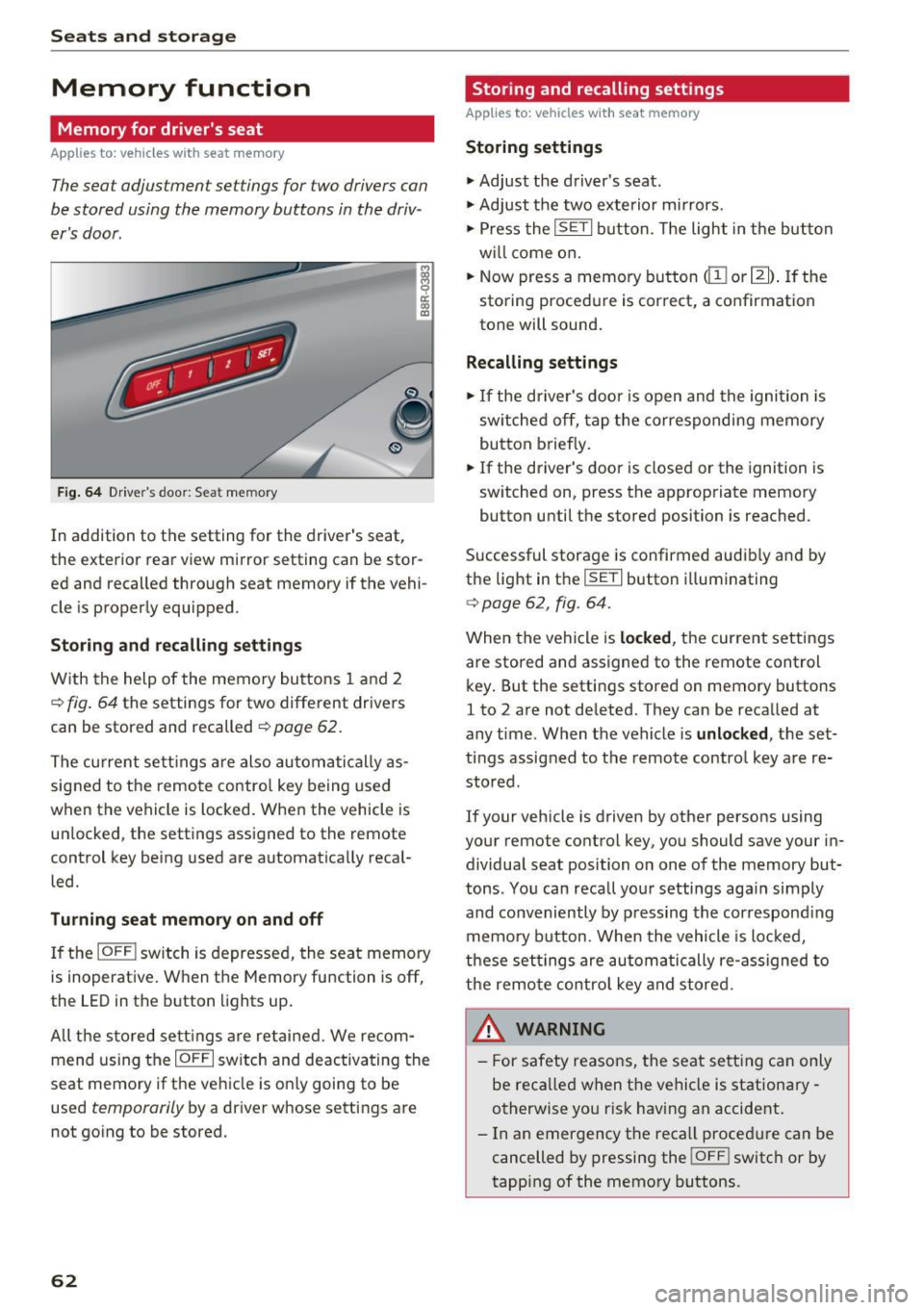
Sea ts and stor age
Memory function
Memory for driver's seat
Applies to: vehicles with seat memory
The seat adjustment settings for two drivers can
be stored using the memory buttons in the driv
e r's door.
F ig . 64 Dr ive r's doo r: Sea t memory
i ci: co a,
In addition to the setting for the drive r's seat,
the exterior rear view mirror setting can be stor ed and recalled through seat memory if the vehi
cle is properly equipped .
Storing and re calling s ettings
With the help of the memory buttons 1 and 2
c> fig . 64 the settings for two different drivers
can be stored and recalled
¢ page 62.
The cu rrent se ttings are also automatically as
signed to the remote contro l key being used
when the vehicle is locked . When the vehicle is
un locked , the settings assigned to the remote
control key being used are automatically recal
led.
Tu rnin g se at memo ry on and off
If the IO FFI switch is depressed, the seat memory
is inoperative. When the Memory function is off,
the LED in the button lights up.
All t he s tored se tt ings are retai ned. We recom
mend using the
I O FF I sw itch and deactivating the
seat memory if the vehicle is on ly going to be
used
temporarily by a driver whose settings are
not going to be stored.
62
Stor ing and recalling settings
Applies to: vehicles with seat memory
Storing settings
.,. Adjust the driver's seat .
.,. Adjust the two exterior mirrors.
.,. Press the
ISETI button . The light in the button
w ill come o n.
.,. Now press a memory button
dII or I]]) . If the
storing procedu re is correct, a confirmation
tone will sound.
Recalling settings
"' If the driver's door is open and the ignition is
sw itched off, tap the corresponding memory
button briefly .
.,. If the driver's door is closed or the ignition is
switched on, press the appropriate memory
button until the stored position is reached .
Successful storage is confirmed audib ly and by
the light in the
ISE TI button illuminating
c> page 62, fig. 64 .
When the vehicle is locked , the current settings
are stored and assigned to the remote control
key . But the settings stored on memory buttons
1 to 2 are not de leted. They can be recalled at
any time . When the vehicle is
unlocked , the set
tings assigned to the remote control key a re re
stored .
If your vehicle is driven by other persons using
your remote control key, you should save your in dividual seat position on one of the memory but
tons . You can recall your settings again simply
and conveniently by p ressing the correspond ing
memory button. When the vehicle is locked,
these settings are automatically re-ass igned to
the remo te contro l key and stored.
A WARNING
- For safety reasons, the seat sett ing can only
be reca lled when the vehicle is stationary
otherwise yo u ris k having an accident.
- In an emergency the reca ll proced ure can be
cancelled by pressing the
! OF F! switch or by
tapping of the memory buttons.
Page 65 of 296
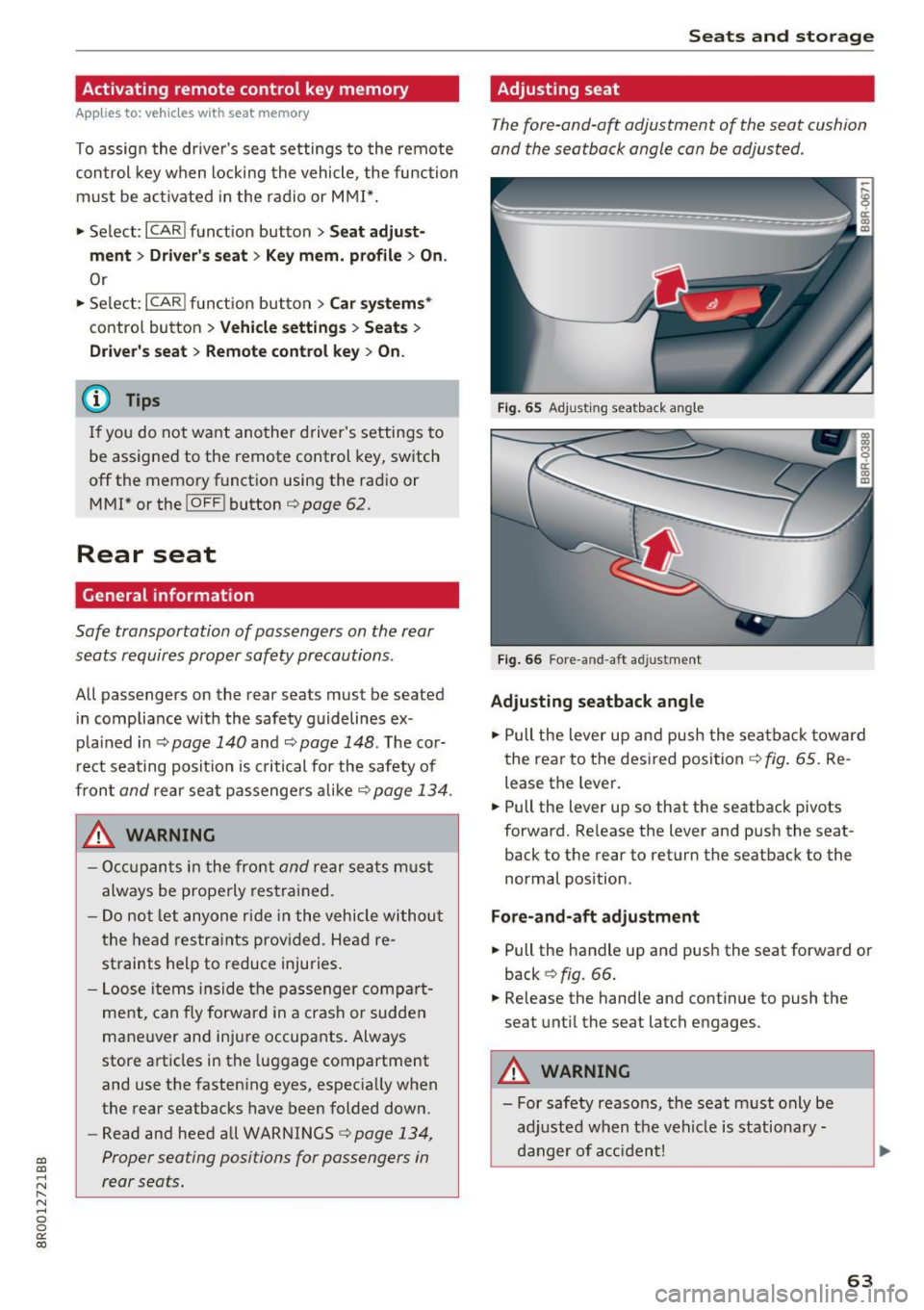
a,
a,
..... N r--N ..... 0 0
0:
co
Activating remote control key memory
Applies to: vehicles with seat memory
To assig n the drive r's seat settings to the remote
con trol key when locking the vehicle , the function
must be act ivated in the ra dio or M MI* .
• Se lect :
I CARI funct ion button > Seat adjust
ment > Driver's seat > Key mem. profile > On .
Or
• Se lect :
I CARI funct ion but ton> Car sy stem s*
contro l bu tton > V ehicle setting s > Seat s>
Dri ver' s seat > Remote control key > On .
(D Tips
If you do not wa nt ano ther d river's settings to
be assigned to the remote control key, sw itch
off the memory funct ion using the rad io or
M MI* or the
!OF F! button 9 page 62 .
Rear seat
General information
Safe transportation of passengers on the rear
seats requires proper safety precautions .
All passengers on the rear seats must be sea ted
in comp lia nce w it h the safety guidelines ex
p la ined in
<=;> page 140 and .:;,page 148. The co r
r ect seating posit ion is critical for the safety of
fron t
and rear seat passenge rs al ik e r::!;> page 134 .
A WARNING
- Occupan ts in the fro nt and rear sea ts m ust
always be properly res trai ned.
- Do not let anyone ri de in t he vehicle with ou t
th e head restra ints prov ided. He ad re
st raints help to reduce injuries.
- L oose i tems inside the passenger compa rt
ment, can f ly forwa rd in a cras h or sudden
maneuver and injure occupants. Always
store articles in the luggage compartment
and use the fasten ing eyes , especia lly when
the rear seatbacks have been folded down.
- Read and heed a ll WARNINGS
¢ page 134,
Proper seating positions for passengers in
rear s eats .
Seats and storag e
Adjusting seat
The fore-and-aft adjustment of the seat cushion
and the seatback angle con be adjusted .
Fig . 65 Adjust ing seatbac k angle
Fig. 66 Fo re -a n d-a ft a dju stm ent
Adjusting seatback angle
• Pull the lever up and pus h the seat back t oward
the rear to the des ired position
r::!;> fig . 65 . Re
lease the lever.
• Pull the lever up so that the seatback pivots
forward. Release the lever and push the seat
back to the rear to ret urn the seatback to the
normal pos ition .
Fore-and-aft adju stment
• Pull the handle up and pus h the seat forward or
back
<=;> fig. 66 .
• Release the handle and continue to push the
sea t unt il the seat latch engages .
A WARNING
- For safety reasons, the seat m ust only be
ad juste d when t he vehicle is st ationary -
da nger of acc iden t!
63
Page 66 of 296
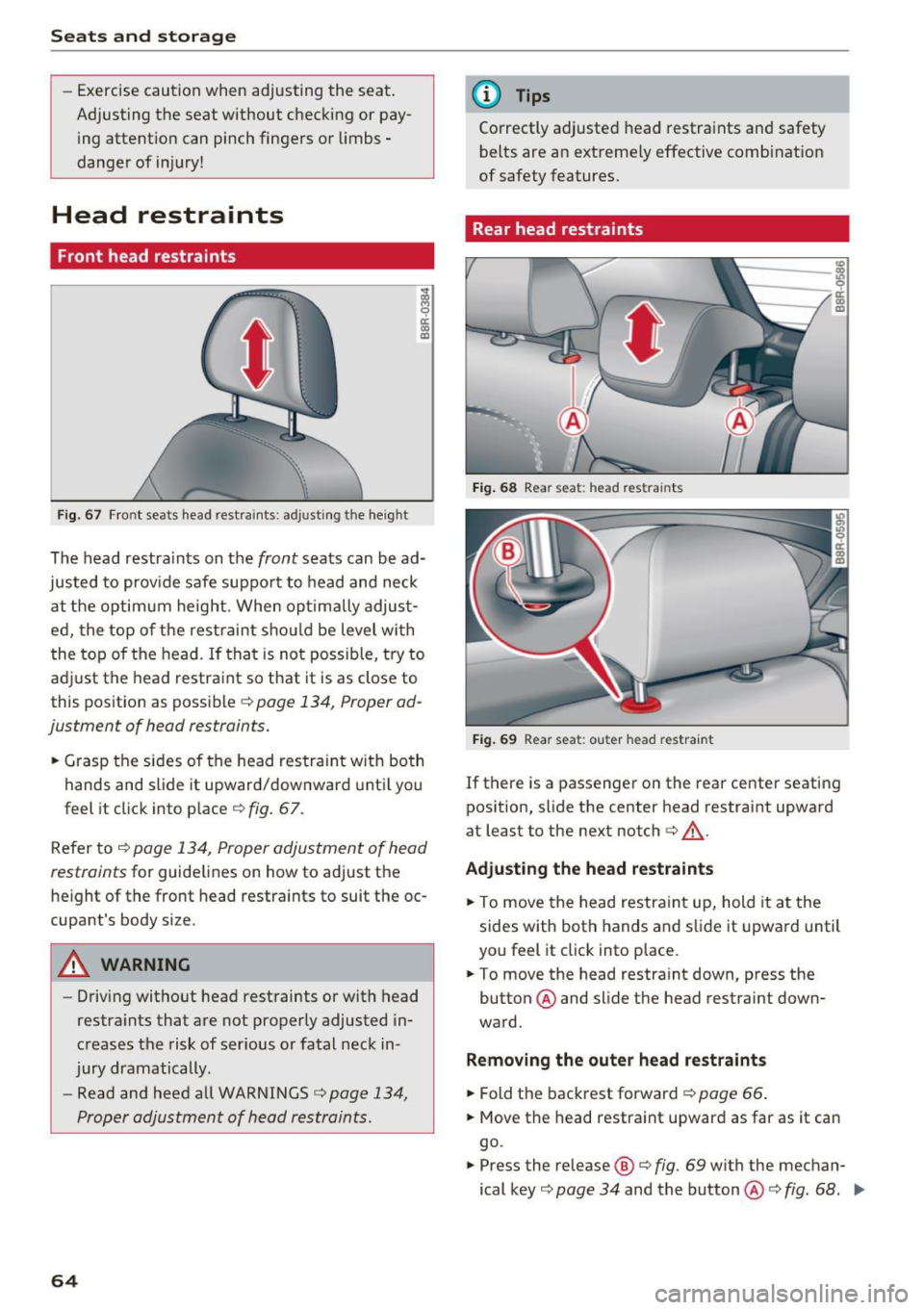
Seats and storage
-Exercise caution when adjusting the seat .
Adjusting the seat without checking or pay
ing attention can pinch fingers or limbs -
danger of injury!
Head restraints
Front head restraints
Fig. 67 Fro nt seats head restrai nts: adj ust ing the he ig h t
The head restra ints on the front seats can be ad
justed to provide safe suppo rt to head and neck
at the optimum height . When optimally adjust
ed, the top of the restraint should be level wi th
the top of the head. If that is not possible, try to
adjust the head restraint so that it is as close to
this position as possibler::!;>
page 134, Proper ad
justment of head restraints.
• Grasp the sid es of the head restraint with both
hands and slide it upward/downward until you
feel it click into place r::!;>
fig. 67.
Refer to
r::!;> page 134, Proper adjustment of head
restraints
for guidelines on how to adjust the
height of the front head restra ints to suit the oc
cupant 's body size.
_&. WARNING
- Driving without head restraints or with head
restraints that are not properly adjusted in
creases the risk of ser ious or fatal neck in
jury dramatically .
- Read and heed all WARNINGS
c:> page 134,
Proper adjustment of head restraints.
64
@ Tips
Correctly adjusted head restraints and safety
belts are an extreme ly effective combinat ion
of safety features.
Rear head restraints
Fig. 68 Rear seat : head rest raints
Fig. 69 Rear sea t: ou ter head restrain t
If there is a passenger on the rear center seating
position, slide the center head restraint upward
at least to the next notch
c:> .&_ .
Adjusting the head restraints
• To move the head restraint up, hold it at the
sides with both hands and slide it upward until
you feel it click into place.
• To move the head restraint down, press the
button @and slide the head restraint down
ward .
Removing the outer head restraints
• Fold the backrest forward r::!;> page 66.
• Move the head restra int upward as far as it can
go .
.,. Press the release@<=>
fig. 69 with the mechan
ical key
c:> page 34 and the button@<=> fig. 68. Iii>-
Page 67 of 296
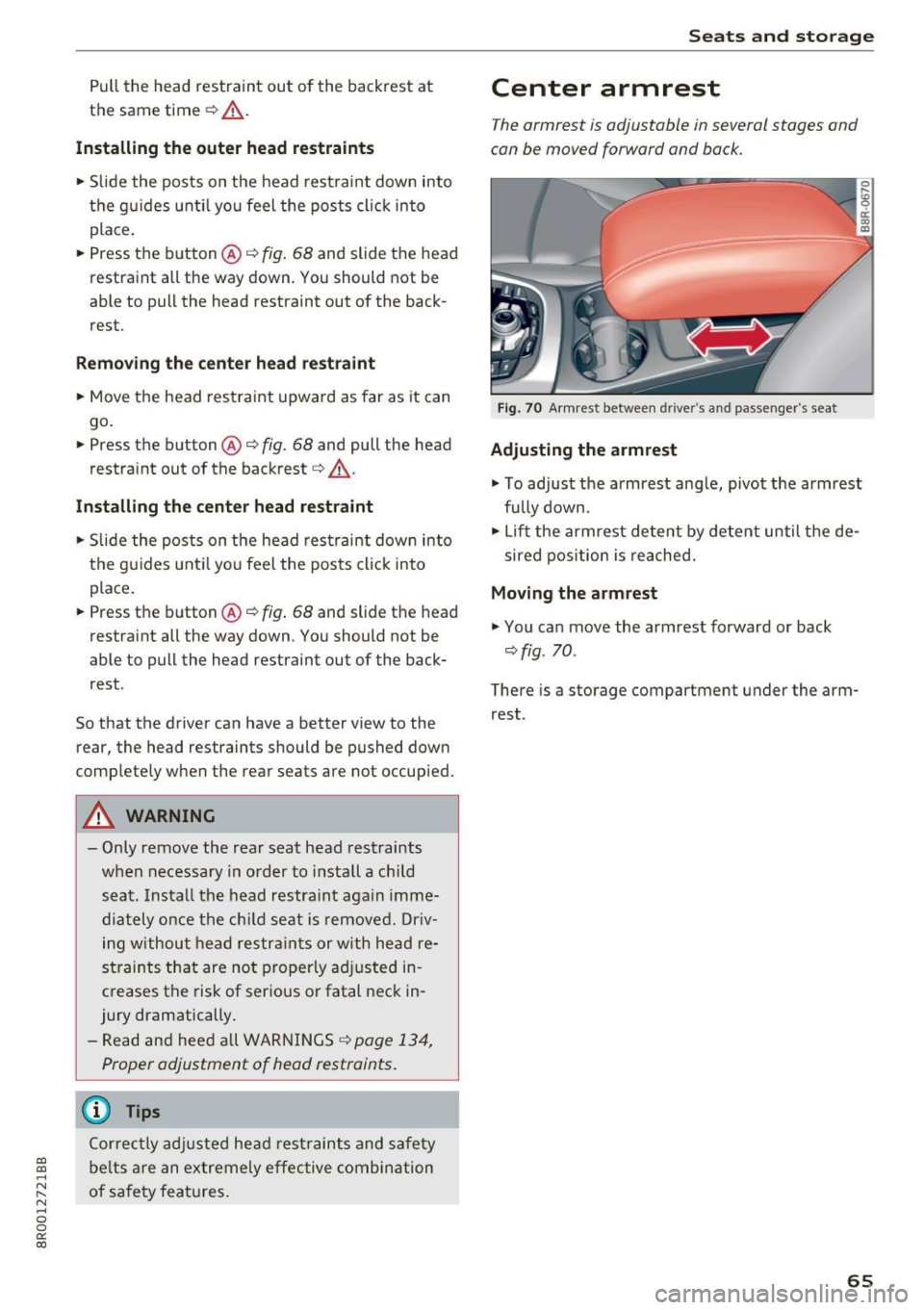
Pull the head restraint out of the backrest at
the same time¢.&_ .
Installing the outer head restraints
~ Slide the posts on the head restra int down into
t h e g uides until yo u feel the posts cl ick into
pla ce .
~ Press the button @c::> fig. 68 and slide the head
restraint all the way down. You should not be
able to pull the head rest raint out of the back
rest.
Removing the center head restra int
~ Move the head res traint upwa rd as far as it can
go .
~ Press t he button @¢ fig. 68 and pull the head
restra int out of the backrest¢.&_ .
Installing the center head restraint
~ Slid e the pos ts on the head res train t dow n into
the gu ides unt il you feel the posts cli ck into
place .
~ Press the button @¢ fig. 68 and slide the head
restra int all the way down . You should not be
able to pull the head restraint out of the back
rest .
So that the driver can have a better view to the rear, the head restra ints should be pushed down
comp letely when the rea r seats are not occup ied.
A WARNING
- Only remove the rear sea t head res trai nts
when necessa ry in ord er to install a chi ld
s e at. Insta ll the head restra int aga in imm e
di ately on ce the c hild seat is re m ove d.
D riv
ing without head re st rai nts or with he ad re
str aints that are no t properly adju ste d in
c reases the risk of ser ious o r fatal neck in
jury dramatically .
- Read and hee d all W AR NIN GS c::>
pa ge 134,
Proper adjustment of head restraints .
(j) Tips
Correc tly adj us ted he ad rest raints and safety
-
~ be lts ar e an ex tremely e ffective combin ation .....
~ of sa fe ty feat ures. N ..... 0 0
0:
co
Seats and storag e
Center armrest
The armrest is adjustable in several stages and
can be moved forward and back.
Fig . 70 A rm rest betwee n dr ive r's and passenger 's sea t
Adjusting the armrest
~ To adjust the armrest ang le, pivot the armrest
fully down .
~ Lift the armrest detent by deten t until t he de
sired position is re ache d.
Moving the armrest
~ You ca n move the armrest forward or back
¢fig. 70.
There is a storage compartment under the arm
rest .
65
Page 83 of 296
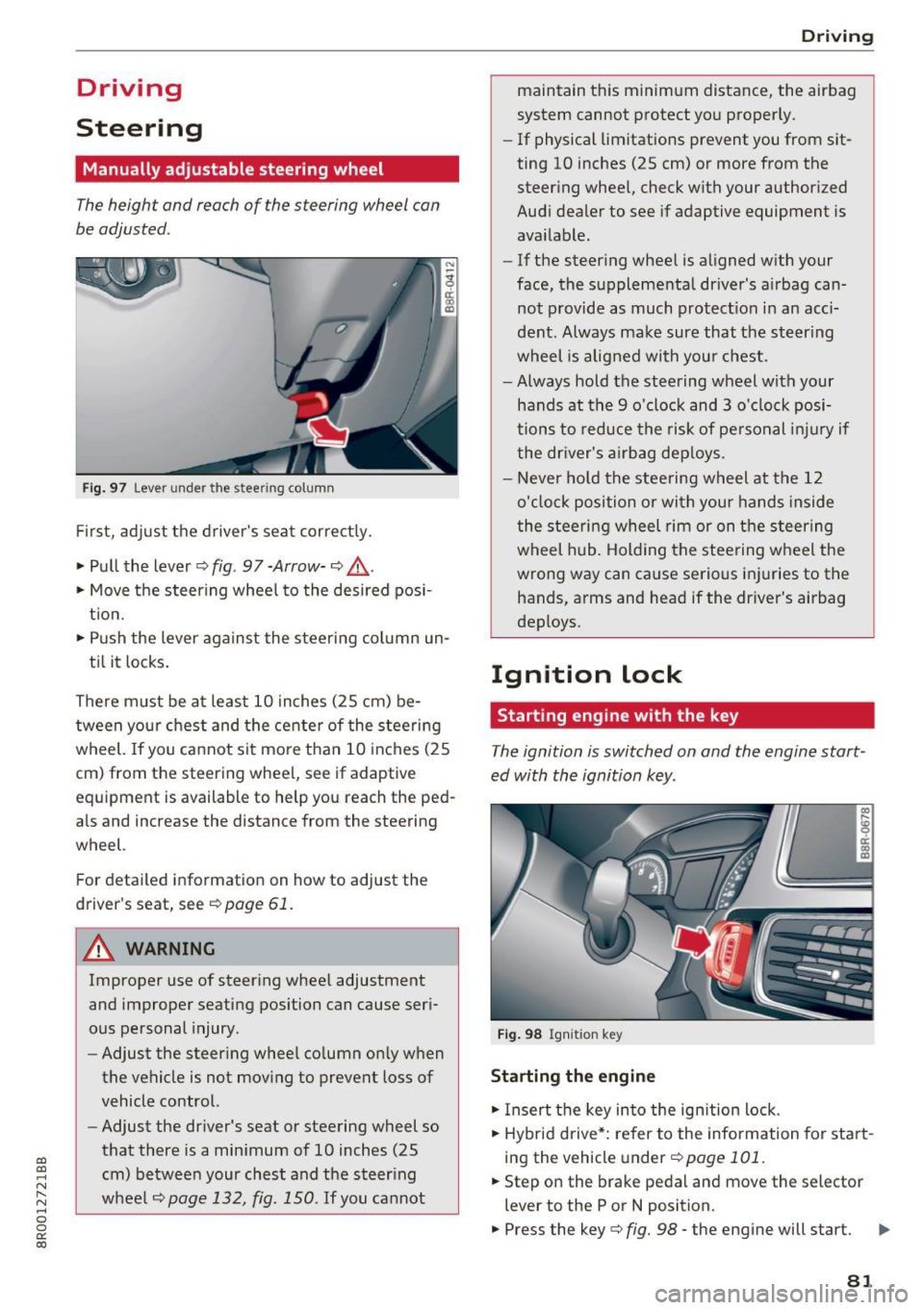
a,
a,
,...,
N l"N ,...,
0 0
0:
co
Driving
Steering
Manually adjustable steering wheel
The height and reach of the steering wheel can
be adjusted .
Fig. 97 Lever under the steering column
Fi rst, ad just t he driver 's sea t correct ly.
• Pull the lever ¢
fig. 97 -Arrow- ¢ A.
• Move the steer ing whee l to the desired posi
t ion.
• Push the lever against the steeri ng column un-
ti l it locks .
There must be at leas t 10 inches (25 cm) be
tween your chest and the center of the stee rin g
wheel. If yo u cannot sit mo re than 10 inches (25
cm) from the steering wheel, see if adaptive
equipment is available to help you reach the ped
a ls and increase the distance from the steering
wheel.
F or detailed information on how to adjust the
driver's seat, see
¢ page 61 .
.&_ WARNING
Improper use of steering wheel adjustment
and improper seating position can cause ser i
ous personal injury.
- Adjust the steering whee l co lumn on ly w hen
the vehicle is not mov ing to prevent loss of
vehicle control.
- Adjust the driver's seat or steering wheel so
that there is a min imum of 10 inches (25
cm) betwee n your chest and t he steer ing
w heel
¢page 132, fig. 150 . If you cannot
-
D rivi ng
maintain t his minim um distance, the airbag
system cannot p rotect yo u proper ly.
- If physical limitations prevent you from sit
ting 10 inches (25 cm) or more from the
steer ing whee l, check with your author ized
Audi dealer to see if adaptive equipment is
ava ilable.
- If the steer ing whee l is aligned w ith your
face, the supplementa l driver's a irbag can
not provide as much protect io n in an acc i
dent. Always ma ke sure that the steer ing
wheel is aligned with you r chest.
- Always hold the steering wheel with your
hands at the 9 o'clock and 3 o' clock posi
tions to reduce the risk of pe rso nal inju ry if
the dr iver's a irbag dep loys .
- Never ho ld the stee ring wheel at the 12
o'cl ock position or wi th you r hands inside
the stee rin g wheel rim or on t he s teer ing
wheel h ub. Holding the stee ring w heel the
wrong way can cause serious inj uries to the
hands, arms and head if the driver's airbag
deploys .
Ignition lock
Starting engine with the key
Th e ignition is switched on and the engine start
ed with the ignition key .
Fig . 9 8 Igh iti oh key
Starting the engine
• Insert the key into the ign ition lock .
• Hybrid drive*: re fer to the information for start
ing the vehicle under
¢ page 101.
• Step on the brake pedal an d move the selector
lever to the P or N position.
• Press the key¢
fig. 98 -the engine will start. II>
81
Page 133 of 296
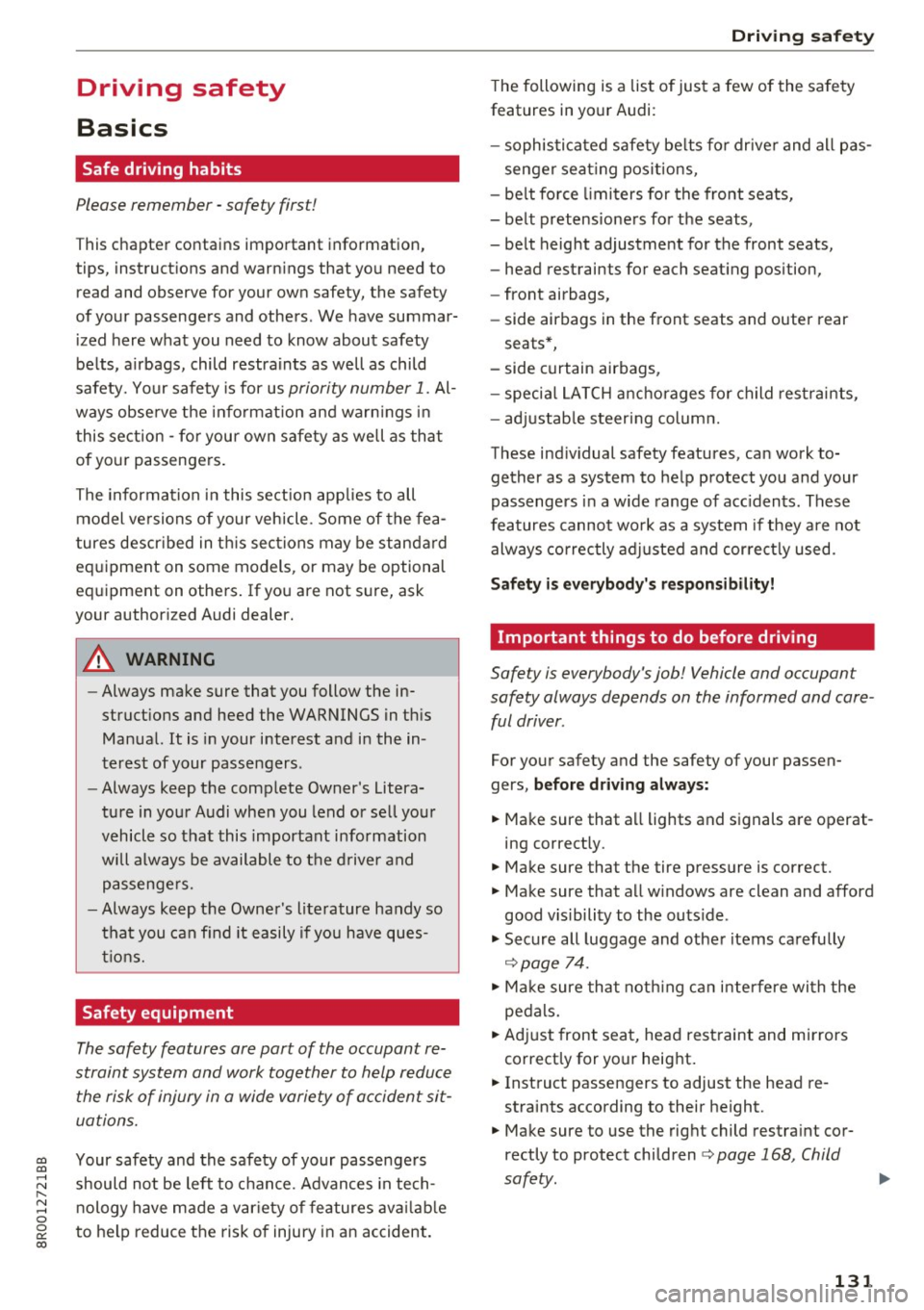
CD
CD
.... N ,-... N ,....,
0 0 C<'. 00
Driving safety
Basics
Safe driving habits
Please remember -safety first!
This chapter contains important information,
tips, instructions and warnings that you need to
read and observe for your own safety, the safety
of your passengers and others . We have summar
ized here what you need to know about safety
belts, airbags, child restraints as well as child
safety. Your safety is for us
priority number 1. Al
ways observe the information and warnings in
this section - for your own safety as well as that
of your passengers.
The information in this section applies to all
model versions of your vehicle. Some of the fea
tures descr ibed in this sections may be standard
equipment on some models, or may be optional
equipment on others. If you are not sure, ask
your authorized Audi dealer.
A WARNING
- Always make sure that you follow the in
structions and heed the WARNINGS in this
Manual. It is in your interest and in the in
terest of your passengers .
-
-Always keep the complete Owner's Litera
ture in your Audi when you lend or sell your
vehicle so that this important information
will always be available to the driver and
passengers.
- Always keep the Owner's literature handy so
that you can find it easily if you have ques
tions.
Safety equipment
The safety features are part of the occupant re
straint system and work together to help reduce
the risk of injury in a wide variety of accident sit
uations.
Your safety and the safety of your passengers
should not be left to chance. Advances in tech
nology have made a var iety of features available
to help reduce the risk of injury in an accident.
Driving safety
The following is a list of just a few of the safety
features in your Audi:
- sophisticated safety belts for driver and all pas-
senger seat ing pos itions,
- be lt force limiters for the front seats,
- belt pretensioners for the seats,
- belt height adjustment for the front seats,
- head restraints for each seating position,
- front airbags,
- side airbags in the front seats and outer rear
seats *,
- side curtain airbags,
- special LATCH anchorages for child restraints,
- adjustab le steering column.
These individual safety features, can work to gether as a system to help protect you and your
passengers in a wide range of accidents . These
features cannot work as a system if they are not
always correctly adjusted and correctly used.
Safety is everybody's responsibility!
Important things to do before driving
Safety is everybody 's job! Vehicle and occupant
safety always depends on the informed and care
ful driver .
For your safety and the safety of your passen
gers,
before driving always:
.,. Make sure that all lights and signals are operat
ing correctly.
.,. Make sure that the tire pressure is correct .
.,. Make sure that all windows are clean and afford
good visibility to the outside .
.,. Secure all luggage and other items carefully
~page 74 .
.,. Make sure that nothing can interfere with the
pedals.
.,. Adjust front seat, head restraint and mirrors
correctly for your height.
.,. Instruct passengers to adjust the head re
straints according to their height.
.,. Make sure to use the right child restraint cor
rectly to protect children
¢ page 168, Child
safety. ..,.
131
Page 136 of 296

Driving sa fe ty
-Always keep your feet on the floor in front
of the seat. Never rest them on the seat, in
strument pane l, out of the window, etc. The
airbag system and safety belt will not be
able to protect you properly and can even in
c rease the risk of injury in a crash .
- Never dr ive with the backrest reclined or
t il ted far bac k! The farther the backrests are
t il ted back, the greater the risk of in ju ry due
to incorrect positioning of the safety belt and imp roper seating position.
- Children must always ride in child safety
seats r=;,
page 168 . Special pre caut ions ap
ply when installing a ch ild safety seat on the
front passenger seat r=;,
page 148.
Proper seating positions for passengers in
rear seats
Rear seat passengers must sit upright wi th both
feet on the floor consistent with their physical
size and be properly restrained whenever the ve
hicle is in use.
To reduce the risk of injury caused by an inco rrect
seating position in the event of a sudden braking maneuver or an accident, your passengers on the
rear bench seat must always observe the follow
ing :
~ If there is a passenger on the rear center seat
ing pos it ion, slide the center head restra int up
ward at least to the next notch r=;,
page 64.
~ Make sure that the seatback is securely latched
in the upright pos ition r=;,
page 66.
~ Keep both feet flat in the footwell i n front of
the rear seat.
~ Fasten and wea r safety be lts p roperly
r:=;, page 143.
~ Make s ure that children are always properly re
strained in a c hild rest raint t hat is appropriate
f or their size and age r=;,
page 168.
A WARNING
Passengers who are improperly seated on the
rear seat can be seriously injured in a crash.
- Each passenger must always sit on a seat of their own and properly fasten and wear the
safety belt belonging to that seat.
134
- Safety belts only offer maximum protect ion
when the seatback is securely latched in the upright pos ition and the safety belts are
properly posit ioned on the body . By not sit
ting upright, a rear seat passenger increases
the risk of personal injury from imprope rly
posi tioned safety belts!
- Always ad just the head restra int properly so
that it can give maximum p rotection.
Proper adjustment of head restraints
Correctly adjusted head restraints are an impor
tant part of your vehicle's occupant restraint sys
tem and can help to reduce the risk of injuries in
accident situations.
Fi g. 1 51 Head restra int: v iewed from t he front
The head restraints must be correctly adjusted to
achieve the best protection.
~ Adjust the head rest raints so the upper edge is
as even as possib le w ith the top of you r head. If
that is not possible, t ry to adjust the head re
straint so that it is as close to this pos it ion as
possible r=;,
fig. 151.
~ If there is a passenger on the rear center seat
ing position, slide the center head restraint up
wa rd at least to the nex t notch .
Adjust ing head restraints r=;,
page 64.
A WARNING -
All seats are equipped w ith head restraints.
Driving w ithout head restraints or w ith head
rest raints tha t are not prope rly adjusted in
creases the r isk of se rious or fata l neck injury
d ra mat ic al ly. To help reduce t he risk of injury:
Ill-
Page 146 of 296

Safe ty belts
Autom ati c s afet y belt retr actors
Every safety belt is equ ipped with an automa tic
be lt retractor on the shoulder belt. This feature
locks the belt when the belt is pulled out fast,
during hard braking and in a n accident. The belt
may a lso lock when you drive up or down a steep
hill or through a sharp curve. Dur ing normal driv
ing the belt lets you
move freely.
Safety belt p ret en sion ers
The safety belts are equipped with a belt preten
sioner that helps to t ighten the safety belt and
remove slack when the pretensioner is activated.
The function of the pretensioner is mon itored by
a warning light
r:::') page 13.
Swi tc hable l ocking f eature
Every safety belt except the one on the driver
seat is equipped with a switchable locking fea
ture that
must be used when the safety belt is
used to attach a child safety seat. Be sure to read
the impo rtant information about this feature
r=;,page 178.
.&_ WARNING
Improperly pos itioned safety be lts can cause
ser ious injury in an accident
c:> page 144,
Safety belt position.
- Safety belts offer optimum protection only
when the seatback is upright and belts are
properly positioned on the body.
- Always make sure that the rear seat bac k
rest to which the center rea r safety belt is
attached is secure ly latched whenever the
rear center safety belt is being used. If the
backrest is not securely latched, the passen
ger will move forward with the backrest dur
ing sudden braking, in a sudden maneuver
and especially in a crash.
- Never attach the safety belt to the buckle for another seat. Attaching the belt to the
wrong buckle wi ll reduce safety belt effec
t iveness and can cause serious persona l in
jury.
- A passenger who is not properly restrained can be seriously in ju red by the safety be lt it
self when it moves from the stronger parts
144
of the body into critical areas like the abdo men.
- Always lock the convertible locking retractor
when you are securing a child safety seat in
the vehicle
c:> page 180.
Safety belt position
Correct belt position is the key to getting maxi
mum protection from safety belts .
Fig. 160 Safety belt posit ion
-"' .... 9 I ... a,
Standard features on your vehicle help you adjust
the position of the safety belt to match your body
s ize.
- belt height adjustment for the front seats,
- height-adjustab le front seats.
.&_ WARNING
Improperly positioned safety belts can cause
serious pe rsonal injury in an acc ident .
- The shoulder belt should lie as close to the
center of the collar bone as possible and
should fit well on the body. Hold the belt
above the latch tongue and pull it evenly
across the chest so that it s its as low as pos
sib le on the pe lvis and there is no p ressure
on the a bdomen . The belt sho uld a lways f it
snug ly
r:::;, fig. 160. Pull on the belt to tig hten
if necessary .
- The lap be lt portion of the safety belt must
be positioned as low as possible across pel
vis and never over the abdomen. Make sure
the belt lies flat and snug
c:> fig. 160. Pull on
the belt to tighten if necessary.
- A loose-fitting safety belt can cause serious injuries by sh ifting its position on your body ..,_